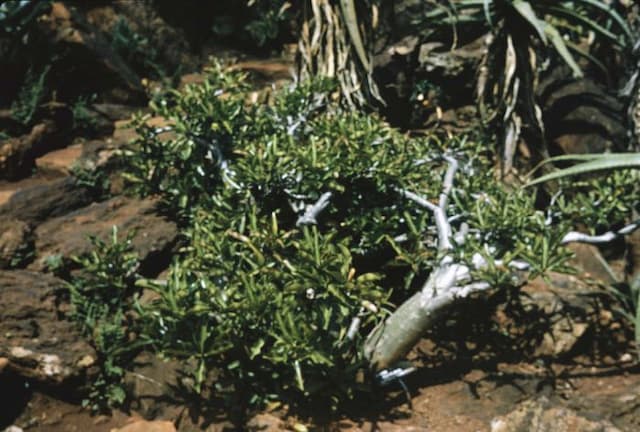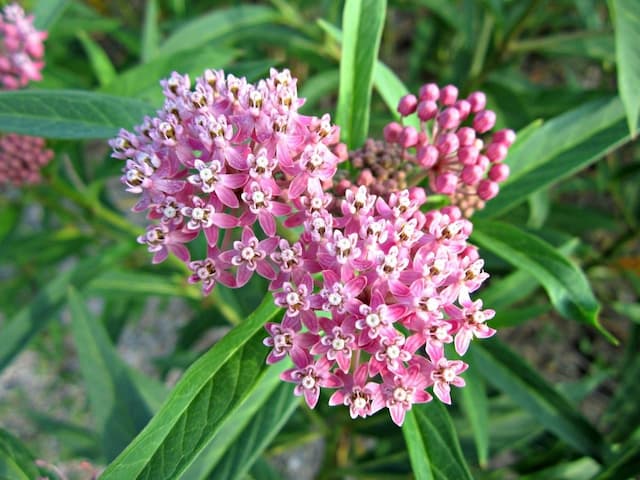Lesser Periwinkle Vinca minor 'Atropurpurea'

ABOUT
Commonly known as the lesser periwinkle or dwarf periwinkle, Vinca minor 'Atropurpurea' is an attractive evergreen perennial with a sprawling habit. It is recognized for its charming flowers and glossy, dark green leaves. Its leaves are small, ovate, and possess a leathery texture, often with a slightly glossy appearance that provides year-round color and cover. The flowers are what particularly set 'Atropurpurea' apart. They bloom with a rich, deep purple hue, providing a striking contrast to the dark foliage. The blossoms typically have a simple, pinwheel shape with five petals that radiate outward, showcasing a delicate, almost velvety appearance. The plant creates a carpet of color when in bloom, making it a popular choice for ground cover in gardens. The blossoms emerge in spring and can continue to appear sporadically throughout the growing season.
About this plant
 Names
NamesFamily
Apocynaceae
Synonyms
Lesser Periwinkle, Dwarf Periwinkle, Small Periwinkle, Common Periwinkle, Creeping Myrtle, Flower-of-Death
Common names
Vinca minor 'Atropurpurea'.
 Toxicity
ToxicityTo humans
The common periwinkle contains alkaloids that can be toxic if ingested. In humans, the symptoms of common periwinkle poisoning can include vomiting, diarrhea, a drop in blood pressure, depression of the central nervous system, and, in severe cases, seizures and coma. Consuming any part of the plant, especially in significant quantities, can be dangerous and medical attention should be sought if ingestion occurs.
To pets
The toxicity of the common periwinkle to pets, such as dogs and cats, is similar to that in humans. The alkaloids present in the plant can cause vomiting, diarrhea, lethargy, loss of appetite, tremors, seizures, and in severe cases, it can be fatal. If a pet consumes any part of the common periwinkle, it is important to seek veterinary care immediately.
 Characteristics
CharacteristicsLife cycle
Perennials
Foliage type
Evergreen
Color of leaves
Dark green
Flower color
Purple
Height
4-6 inches (10-15 cm)
Spread
1-1.5 feet (30-45 cm)
Plant type
Creeper
Hardiness zones
4-9
Native area
Europe
Benefits
 General Benefits
General Benefits- Low Maintenance: Requires minimal care once established, making it an ideal plant for gardeners with limited time.
- Drought Tolerant: Can survive with relatively low water intake after it has been established, suitable for xeriscaping.
- Ground Cover: Spreads to cover ground effectively, which can help prevent soil erosion and suppress weed growth.
- Semi-Evergreen: Retains leaves through much of the winter, providing year-round greenery in many climates.
- Shade Tolerant: Thrives in partial to full shade, making it ideal for underplanting beneath trees or in other low-light areas of the garden.
- Decorative Flowers: Produces attractive purple flowers, adding aesthetic value to the garden landscape.
- Rabbit Resistant: Generally not preferred by rabbits, which can help prevent damage to the garden.
- Easy Propagation: Can be easily propagated from cuttings or by division, allowing gardeners to expand their plantings with little additional cost.
- Tolerates Poor Soil: Adaptable to a range of soil conditions, including poor soils, as long as they are well-drained.
- Deer Resistant: The plant is not favored by deer, protecting it from grazing in areas with deer populations.
 Medical Properties
Medical Properties- Alkaloid production: Vinca minor 'Atropurpurea' contains alkaloids that may have potential pharmacological effects.
- Cognitive enhancement: Some of its alkaloids, particularly vincamine, have been researched for their potential in improving cerebral blood flow and cognitive function.
- Antimicrobial activity: Extracts from Vinca minor have displayed antimicrobial properties in some studies.
 Air-purifying Qualities
Air-purifying QualitiesThis plant is not specifically known for air purifying qualities.
 Other Uses
Other Uses- Vinca minor 'Atropurpurea', commonly known as Lesser Periwinkle, may be used as a stabilizing agent for soil on slopes and embankments to prevent erosion due to its dense mat-forming growth habit.
- The plant serves as an evergreen ornamental ground cover in landscaping for gardens and parks, providing aesthetics throughout the year with its purple flowers and glossy leaves.
- Lesser Periwinkle can be planted in shady areas where other plants might struggle to grow, thanks to its shade tolerance.
- The dense foliage of the Lesser Periwinkle provides a habitat for small garden creatures, such as beneficial insects and amphibians, contributing to local biodiversity.
- The trailing stems of Lesser Periwinkle are sometimes used in floral arrangements as a filler to add greenery and structure to bouquets and wreaths.
- Lesser Periwinkle has been used traditionally in some cultures to create a natural dye for fabric, although it is not its primary use.
- In art, the flowers of Lesser Periwinkle can be pressed and used in crafts to create bookmarks, cards, and other decorative items due to their retained color after drying.
- Due to its fast and dense growth, Lesser Periwinkle can be used to outcompete and suppress the growth of weeds in garden beds.
- The plant can sometimes be used in sensory gardens, as the texture of its leaves and the visual appeal of its flowers can be stimulating and contribute to the sensory experience.
- Lesser Periwinkle may be used as a living mulch, as it can cover the soil and help retain moisture while adding organic matter as its leaves shed and decompose.
Interesting Facts
 Feng Shui
Feng ShuiThe Lesser Periwinkle is not used in Feng Shui practice.
 Zodiac Sign Compitability
Zodiac Sign CompitabilityThe Lesser Periwinkle is not used in astrology practice.
 Plant Symbolism
Plant Symbolism- Perseverance: Commonly known as Lesser Periwinkle, Vinca minor 'Atropurpurea' is a hardy groundcover that thrives in various conditions, symbolizing one's ability to persist through challenges.
- Everlasting Love: With its evergreen foliage and recurrent blooms, Lesser Periwinkle is often associated with enduring affection and love that lasts all year round.
- Memories: In some traditions, Lesser Periwinkle represents fond memories and is sometimes planted in remembrance of loved ones.
- Friendship: The circular nature of its growth and the way it covers the ground can represent the encompassing and supportive nature of friendship.
- Death: In some European cultures, Lesser Periwinkle was often laid on the graves of children, symbolizing an untimely death and the hope for eternal life.
 Water
WaterCommon Periwinkle requires watering whenever the top inch of soil feels dry to the touch, roughly every 1-2 weeks. It's crucial to water deeply and slowly, allowing the water to seep into the soil to reach the roots, which will promote a healthier root system. On average, use about 1 gallon of water per plant for each watering session, depending on the size of the plant and environmental conditions. Always check the soil moisture before watering to avoid overwatering, which can lead to root rot.
 Light
LightCommon Periwinkle thrives best in partial shade to full shade, making it suitable for planting under trees or on the north side of a building. Although it can tolerate some morning sun, it should be protected from the intense afternoon sunlight, which can scorch the leaves and damage the plant.
 Temperature
TemperatureCommon Periwinkle is hardy and can tolerate a wide range of temperatures, thriving best between 60 to 75 degrees Fahrenheit. It can withstand minimum winter temperatures down to around -20 degrees Fahrenheit. However, it will suffer if exposed to extremes beyond these ranges for prolonged periods.
 Pruning
PruningPruning Common Periwinkle is essential to control its spread and maintain a tidy appearance. Prune in late winter or early spring before new growth begins. You can cut back the plants by about one-third of their height to encourage dense, bushy growth. This plant responds well to pruning, so don't hesitate to trim as often as needed to keep it within bounds.
 Cleaning
CleaningAs needed
 Soil
SoilCommon Periwinkle thrives in well-draining soil rich in organic matter with a pH of 6.0 to 7.5. A mixture of garden soil, peat moss, and perlite in equal parts creates an ideal growing medium for this plant.
 Repotting
RepottingCommon Periwinkle is a groundcover and is typically not repotted often; it's usually planted outdoors where it can spread. If grown in containers, repotting every 2-3 years or when rootbound can be beneficial.
 Humidity & Misting
Humidity & MistingCommon Periwinkle is not particularly humidity-sensitive and can thrive in average ambient outdoor humidity levels. It is generally adaptable to the humidity levels found in most outdoor garden settings.
 Suitable locations
Suitable locationsIndoor
Place in bright, indirect light and water moderately.
Outdoor
Plant in partial shade or full sun, and water regularly.
Hardiness zone
4-9 USDA
 Life cycle
Life cycleVinca minor 'Atropurpurea', commonly known as Lesser Periwinkle or Dwarf Periwinkle, commences its life as a seed, which upon germination gives rise to small seedlings that bear the plant's characteristic dark green leaves. As the seedlings grow, they develop a network of roots and stems that allow them to spread across the ground. The plant reaches maturity as it begins to flower, producing its distinctive purple flowers that attract pollinators and enable sexual reproduction through the production of seeds. After pollination, the flowers develop into fruit that contains seeds, which, when dispersed, can lead to the establishment of new plants. Throughout its life cycle, Vinca minor 'Atropurpurea' can also propagate asexually through vegetative means, as stem cuttings or broken segments can root and grow into new plants. The plant is perennial, continuing its cycle of growth and reproduction for several years, with the potential to bloom from spring to frost in favorable conditions.
 Propogation
PropogationPropogation time
Spring-Fall
The most popular method of propagating Vinca minor 'Atropurpurea', commonly known as Lesser Periwinkle or Dwarf Periwinkle, is through stem cuttings. The best time for this is in the late spring to early summer when the plant's growth is most vigorous. To propagate, select a healthy, non-flowering shoot and cut a piece around 4-6 inches long. Remove the leaves from the lower half of the cutting to prevent rotting when planted. Dip the cut end into rooting hormone to encourage root development. Then, plant the cutting in a pot filled with a mixture of peat and perlite, ensuring the leafless part is buried. Water the medium well and cover the pot with a clear plastic bag to maintain humidity. Place the pot in a warm spot with indirect sunlight and keep the soil moist but not waterlogged. Rooting usually occurs within 4-6 weeks, at which point the new plants can be transplanted into individual pots or into the garden.









